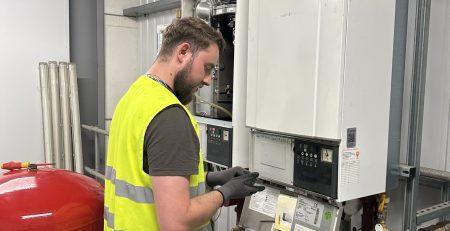Pressurisation Unit
Most modern HVAC systems such as LTHW (low temperature hot water) or CHW (chilled water) will probably utilise a pressurisation unit at some location in the plant room.
The pressurisation unit helps to maintain the pipe line at a determined pressure. From initially filling the system, pressure is lost due to air and minor leaks. As a general rule once any dissolved air has been removed and assuming there are no leaks, the system pressure should level out and be constant. If the system expansion has been sized and installed correctly, very little variation will be noticed.
Pressurisation Units come in many different types and sizes to suit any size of system. In most cases a pump controlled by pressure switches is responsible for increasing the final system pressure.
Fresh water, generally from the MCWS (mains cold water system), is fed into the pressurisation units internal tank where it is stored ready for use. The tank automatically fills from a float valve or a sensor and solenoid valve. As water is required for the secondary circuit, the pump starts up and forces the water into the sealed system causing the pressure to increase. A non return in the pump discharge line holds the pressure when the pump eventually shuts down.
The use of an internal tank inside the pressurisation unit forms a physical barrier between the incoming fresh water supply and the pressurised system. A carefully positioned over flow pipe from the tank will prevent the secondary water from ever syphoning back into the fresh water. Polluted water is therefore prevented from entering the fresh water supply, which could be drinking water.
Because the pressurisation unit has this physical barrier and back flow prevention it can be connected directly to a drinking water main.
Various types of pumps are used in different designs and applications. Some of the smaller commercial pumps use a Solenoid diaphragm pump, the same technology used in carpet cleaning machines and vending equipment. A solenoid pump is powered from an AC mains source through a diode. As the AC wave form is in the positive area a shaft inside the pump connected to a diaphragm is forced open causing low pressure inside the pump and liquid to be sucked into the pump cavity.
When the mains supply wave form passes to the negative area, the diode prevents current flow and the internal shaft is returned back to its off position with the use of a spring. These pumps incorporate an internal non return valve at the inlet which prevents a loss of pressure when the pump is turned off. Larger pressurisation units contain larger pumps using an array of technologies that all achieve the same result.
A good quality pressurisation unit will have at least some intelligence that can identify a leak on the pressurised system. A very small leak on a pipe joint for example could take hours before the pressure drop bears any significance. A burst pipe however would cause a significant drop in a short space of time. Ideally having the unit top up the system for very small pressure fluctuations is good, but trying to fill a system with a burst pipe for example is to be avoided and would simply add to the buildings damage.
With todays modern plant rooms being controlled by a BMS or control panel, there are alarm connections from the pressurisation unit that can be used including low pressure, high pressure and general alarms. Picking up and interfacing these alarms can shut down pumps and interlock boilers to prevent irreparable damage to other areas of the plant when system water pressure becomes out of spec.

We recently replaced a failed pressurisation unit at a local distribution centre in Bilston. The current unit was just over ten years old and despite having a number of internal components replaced, spurious leaks were occurring inside the unit annually. A common trait of the cheaper pumped units.
We removed the aged kit and replaced it with a Mikrofill 3 pressurisation unit. The Mikrofill 3 unit does not have an internal pump and thus relies on the mains cold water pressure to charge the secondary system.
If the incoming water pressure is higher than the secondary pressure by a small margin, the Mikrofill 3 will interface perfectly. Having no pump is less to go wrong and can only lead to less maintenance.
A clever arrangement of internal valves opens and closes to disconnect the secondary pressurised circuit from the mains cold water supply, dumping any fluid remaining into the drain pipe when charging is finished. As such, the unit is compliant as a back flow prevention device.
Not only does the Mikrofil 3 have a large, clear colour screen displaying information about the system its fully configurable to give multiple alarms should something occur to the system.
Leak detection and prevention is a big part of the Mikrofill 3 pressurisation unit so you can trust it to help limit damage should the worst every happen.
Programming and commissioning the unit is a breeze with simplified button controls and an easy to read LCD screen.
Hamer Mechanical Services Ltd would be pleased to assist you with any pressurisation unit supply, installation, issues or requirements. Please contact us for more details.
In the mean time, why don’t you visit the official Mikrofill 3 website by clicking here.
You can also visit our commercial heating page by clicking here.










